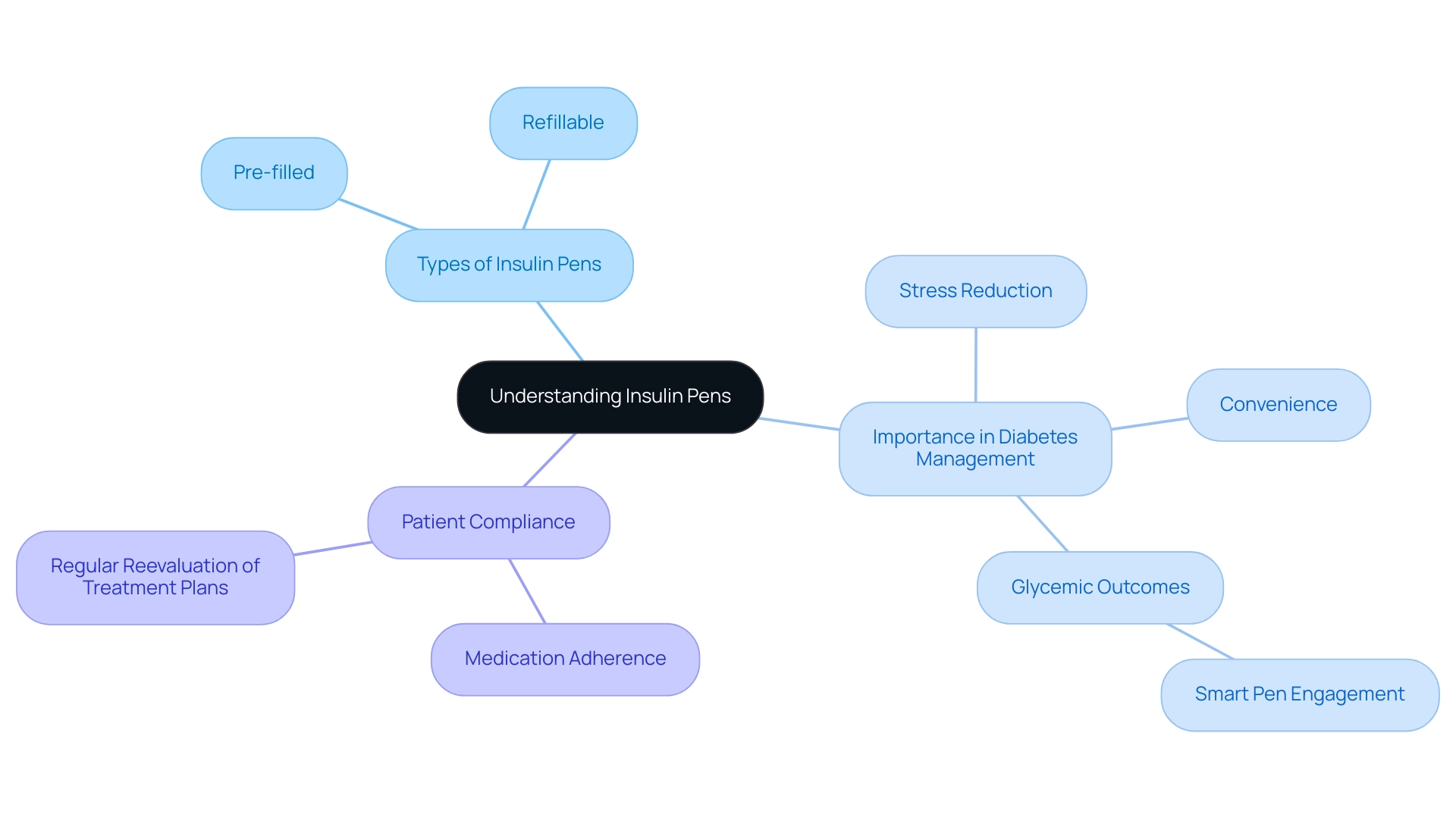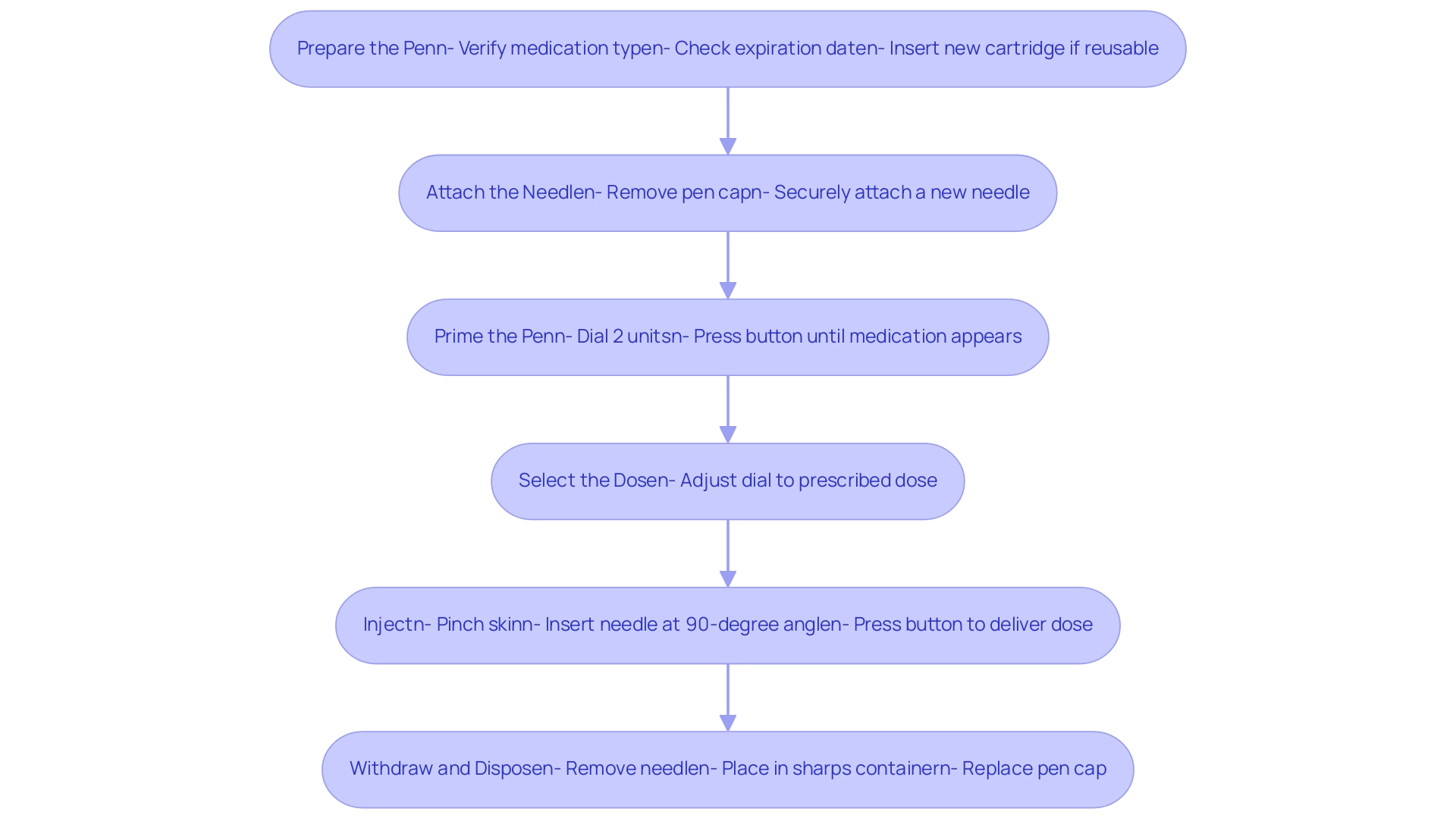Overview
An insulin pen for diabetes is a medical device designed to facilitate the administration of insulin, offering a more convenient and discreet alternative to traditional syringes, which enhances patient compliance and improves glycemic outcomes. The article emphasizes its importance by discussing the various types of insulin pens, their benefits and drawbacks, and the positive correlation between smart pen engagement and better blood sugar management, highlighting the necessity of effective delivery systems in the context of rising diabetes prevalence.
Introduction
In the realm of diabetes management, insulin pens have emerged as a pivotal tool, transforming the way patients administer insulin. These devices not only offer a convenient alternative to traditional syringes but also play a significant role in enhancing treatment adherence and overall patient outcomes.
As the prevalence of diabetes continues to rise, understanding the various types of insulin pens, their usage, and the associated benefits and challenges becomes increasingly important.
This article delves into the essential aspects of insulin pens, from their functionality and selection criteria to practical usage tips and the future of smart insulin delivery systems.
By equipping patients with knowledge and resources, T2DSolutions aims to empower individuals on their journey toward effective diabetes management.
Understanding Insulin Pens: Definition and Importance
An insulin pen for diabetes is a sophisticated medical tool specifically designed for administering this hormone to individuals managing diabetes. This device, an insulin pen for diabetes, improves the delivery of medication by providing a more convenient and discreet alternative to traditional syringes. Syringes are offered in two types:
- Pre-filled with medication for prompt use
- Refillable with cartridges, enabling accurate dosage modifications suited to personal requirements
The importance of the insulin pen for diabetes goes beyond simple convenience; it plays a vital role in enhancing patient compliance with hormone therapy by reducing the stress frequently linked to injections. Recent studies have shown that smart pen engagement correlates positively with glycemic outcomes, as noted by Thomas P.A. Danne, who stated, 'Smart pen engagement was associated positively with glycemic outcomes.'
This highlights their effectiveness in managing blood sugar levels. As the age-adjusted prevalence of diabetes has increased to 13.2% between 2017 and 2020, adopting convenient medication delivery systems such as injectors becomes increasingly essential. Furthermore, regular reevaluation of diabetes treatment plans, as highlighted in case studies, is essential for achieving individualized glycemic goals.
The insulin pen for diabetes facilitates this process, promoting consistent treatment adherence and enhancing overall health outcomes. As T2DSolutions launches as a new resource hub for Type 2 and Type 3 health education and community support, we aim to provide recently diagnosed individuals with comprehensive information and tools, including guidance on effective management of glucose. We invite you to subscribe to T2 Solutions for updates on educational resources, support services, and community engagement opportunities that can empower you in your health management journey.

Types of Insulin Pens: Choosing the Right One for You
T2DSolutions is committed to providing recently diagnosed patients with vital tools for managing diabetes, including information on hormone delivery techniques like the insulin pen for diabetes. These writing instruments are categorized into disposable and reusable types, with major players in the market like Novo Nordisk, Sanofi, and Medtronic leading their development. Disposable injection devices are pre-filled for single use, providing convenience without the need for refills.
In contrast, reusable injection devices enable users to change the cartridge, resulting in savings over time. These writing instruments may also include adjustable dosing mechanisms, tailored to individual patient needs. With a diabetes prevalence of 16.9% reported in Mexico in 2021, understanding effective hormone delivery methods is crucial.
As the market evolves, the insulin pen for diabetes management has emerged as a significant revenue-generating segment in the U.S. and is projected to grow rapidly. T2DSolutions encourages individuals to consult with healthcare professionals to find the best insulin pen for diabetes that fits their lifestyle and treatment plan. By engaging with T2D Solutions, individuals can gain a deeper understanding of their options and receive community support in their health management journey.
How to Use an Insulin Pen: A Step-by-Step Guide
At T2DSolutions, we understand that mastering the insulin pen for diabetes usage is crucial for effective diabetes management. Our resource hub aims to provide newly diagnosed patients with comprehensive support and education on this essential skill. Here’s a systematic approach to using an insulin pen for diabetes management effectively, along with how T2D Solutions can assist you:
-
Prepare the Pen:
Verify the type of medication and check the expiration date. If using a reusable pen, ensure a new cartridge is inserted. T2DSolutions offers tutorials on recognizing different types of diabetes medication, such as the insulin pen for diabetes. -
Attach the Needle:
Remove the pen cap and securely attach a new needle. -
Prime the Pen:
Dial a small dose, typically 2 units, and press the button until the medication appears at the needle tip. Our community forums allow you to ask questions and share experiences about this step. -
Select the Dose:
Adjust the dial to set the prescribed dose as advised by your healthcare provider. -
Inject:
Pinch the skin at the chosen injection site, insert the needle at a 90-degree angle, and press the button to deliver the dose. -
Withdraw and Dispose:
Remove the needle and place it in a designated sharps container, then replace the pen cap. Following these steps is crucial for effective medication delivery.
T2DSolutions also provides case studies and testimonials from users who have benefited from our educational resources about using an insulin pen for diabetes, emphasizing the importance of proper technique in achieving optimal blood sugar control. As educator Elizabeth V. Hillyer states, 'Effective administration of an insulin pen for diabetes is foundational to managing the illness.' By combining technical guidance with community assistance, T2 Solutions is dedicated to improving health outcomes.

Pros and Cons of Insulin Pens: Weighing Your Options
The insulin pen for diabetes provides significant benefits in diabetes management, such as increased convenience, easy operation, and better dosing accuracy. Their portability and discreet design make them particularly suitable for individuals with active lifestyles, facilitating on-the-go administration. However, these benefits come with certain drawbacks.
A major issue is the expense: diabetes medication delivery devices are often pricier than conventional disposable syringes, possibly imposing a financial burden on individuals. A recent cost comparison study, presented at the APhA2024 Annual Meeting and Exposition, highlighted that individuals utilizing pen devices faced higher treatment-related expenses compared to those using disposable syringes, emphasizing the financial burden associated with more advanced methods of delivering medication. Furthermore, some users encounter challenges with priming the device or accurately dialing the correct dose, which can lead to frustration.
It's also important to mention that not all types of this hormone are suitable for delivery devices, which may limit choices for some individuals. According to insights from endocrinologist Jubbin J Jacob, only 22.2% of patients using devices such as the insulin pen for diabetes achieved optimal HbA1c levels (6–7.5%), compared to a mere 2.2% among those utilizing syringes. Additionally, a recent article published in BMC Endocr Disord discussed the simplicity, convenience, safety, and cost-effectiveness of using an insulin pen for diabetes versus disposable syringes, providing a broader context for these findings.
This difference highlights the importance for individuals to thoughtfully evaluate these advantages and disadvantages when determining if these delivery devices meet their health management requirements.
The Future of Insulin Delivery: Smart and Connected Pens
As progress in glucose delivery systems continues to arise, it is crucial to combine these innovations with educational materials and support networks for recently diagnosed individuals. Smart and connected insulin pens for diabetes, for instance, not only improve management of the condition by enabling users to monitor insulin doses and synchronize data with mobile applications, but they also signify an essential element of a comprehensive care strategy. By merging these technological advancements with educational initiatives, T2DSolutions can offer newly diagnosed individuals the tools they need to effectively manage their condition.
This holistic approach ensures that patients receive the necessary information and community support, ultimately improving their quality of life and empowering them to take charge of their diabetes management.
Conclusion
Insulin pens have revolutionized diabetes management, offering a convenient and effective means of administering insulin. Their design, whether disposable or reusable, caters to various patient needs, enhancing treatment adherence and promoting better health outcomes. By alleviating the anxiety linked to injections, insulin pens not only simplify the administration process but also encourage consistent use, which is critical for maintaining glycemic control.
Understanding how to use these devices properly is essential for optimal results. The step-by-step guidance provided ensures that patients feel empowered to manage their insulin therapy confidently. Community support and educational resources, such as those offered by T2DSolutions, play a vital role in helping individuals navigate their diabetes journey and improve their self-management skills.
While the advantages of insulin pens are significant, potential drawbacks such as cost and usability challenges must be carefully considered. Balancing these factors is crucial for patients when deciding on their insulin delivery method. With the advent of smart and connected pens, the future looks promising, as these innovations will further enhance diabetes management by integrating technology with patient education and support.
In summary, insulin pens represent a critical advancement in diabetes care, offering both convenience and improved outcomes. By equipping patients with the knowledge and resources to utilize these devices effectively, it is possible to foster a more empowered approach to diabetes management, ultimately leading to better health and quality of life.
Frequently Asked Questions
What is an insulin pen for diabetes?
An insulin pen for diabetes is a sophisticated medical tool designed for administering insulin to individuals managing diabetes, offering a more convenient and discreet alternative to traditional syringes.
What types of insulin pens are available?
There are two types of insulin pens: pre-filled pens for immediate use and refillable pens that allow users to change cartridges for accurate dosage adjustments.
How does the insulin pen improve patient compliance?
The insulin pen reduces the stress associated with injections, which enhances patient compliance with hormone therapy and promotes consistent treatment adherence.
What is the significance of smart pen engagement in diabetes management?
Recent studies indicate that smart pen engagement is positively correlated with glycemic outcomes, suggesting that these devices are effective in managing blood sugar levels.
Why is the adoption of insulin pens becoming increasingly essential?
With the age-adjusted prevalence of diabetes rising to 13.2% between 2017 and 2020, convenient medication delivery systems like insulin pens are crucial for effective diabetes management.
What resources does T2DSolutions provide for diabetes management?
T2DSolutions aims to offer comprehensive information and tools for recently diagnosed individuals, including guidance on effective glucose management and updates on educational resources and community support.
What are the differences between disposable and reusable insulin pens?
Disposable insulin pens are pre-filled for single use, while reusable pens allow users to change the cartridge, which can result in cost savings over time.
Who are the major players in the insulin pen market?
Major players in the insulin pen market include Novo Nordisk, Sanofi, and Medtronic, which lead the development of these devices.
How prevalent is diabetes in Mexico?
As of 2021, the prevalence of diabetes in Mexico was reported to be 16.9%, highlighting the importance of understanding effective hormone delivery methods.



